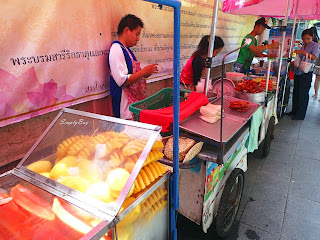Lotus flower is an auspicious symbol and the most poignant representation in Buddhist teaching. It grows in muddy water, and it is this environment that gives forth the flower's first and most literal meaning: rising and blooming above the murk to achieve enlightenment. The mud represents an important meaning of the lotus flower in Buddhism. All humans are born in a world where there is suffering. This suffering is a vital part of the human experience; it makes us stronger and teaches us to resist the temptation of evil in accordance to the Law of Karma. When we banish evil thoughts from our mind we are able to break free of the muddy water and become one with the Buddha. The mud shows us who we are and teaches us to choose the right path.
Strolling along the streets in Bangkok you can easily find an abundance of sidewalk stalls selling fresh fruit juices on a hot sunny day. For tourist this is a pleasant sight. Nevertheless, fresh jasmines and lotus flowers are commonly available nearby any temples in this Buddhist country where Buddhism is still flourishing.
Picking up a sentence from the above paraphrase, the murky water below the lotus flower is just like the world we are living now. When we see something that is pleasant to the eyes, or smelling a nice aroma to the nose, feelings arises and generate good feelings. Hence, emotion is a complex feeling that can be classified into pleasant feeling, neutral feeling or unpleasant feeling. And upon seeing something unpleasant such as an enemy at sight or smelling a stench of bad odor, unpleasant feelings arises and unknowingly activates bad emotion in us. This is life in the murky water.
Unpleasant feeling that leads to negative emotion is hard to control with a tainted mind. Therefore, the lotus flower is a good analogy in the Buddhist religion to help us understand that the mind needs guidance to get fresh air with the correct training inside a pool of murky water. This is how Lord Sakyamuni Gotama Buddha attained enlightenment in this world more 2,500 years ago.
If you're in Bangkok's busy shopping area and wanted to pay a visit to a temple, look no further than a short stroll to Wat Pathum Wanaram or Lotus Temple situated just next to Siam Paragon. This temple was renovated in late 2011 and was once a residence of King Rama IV. During that period this temple was surrounded by lotus ponds. Built in honor of Queen Thepsirintra and completed in 1857, the King named this temple Pathum Wanaram. It is also known as Wat Sra Pathum or Wat Sra.
Enshrined in the Ubosot is the main Buddha image known to locals as Phra Sai which was brought from Vientiane, Laos during the reigh of King Rama III. The colorful murals inside this hall feature giat lotuses and a royal barge possession to the lotus pond. The two Buddha images enshrined in the Viharn (assembly hall) dated back to past era from Laos and they are known as Phra Soem (seated inside an enclosure) and Phra Saen (sitted in front). The entrance door to this Viharn depicts nagas in human form emerging from a lotus pond.
Behind the main temple compound is Wat Pathum Wanaram Chedi and the Sala Phra Rachasattha (pavillion) where sacred relics are enshrined. A peaceful green area surrounding statues of Lord Buddha and various Hindu deities.
Getting There
The temple entrance is about 200 meters from Siam BTS. In Bangkok, the quickest way to get anywhere is by BTS train networks. It's very easy to look for this temple and it's impossible that you won't find it. A visit to Lotus Temple is rewarding if you're ever in Siam Paragon the next time.
Next Article Story
































